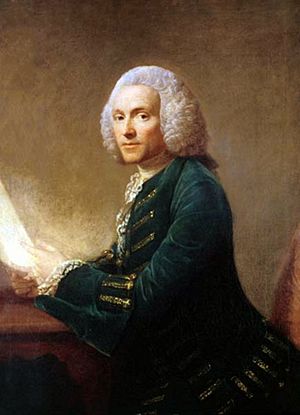William Hunter (anatomist) facts for kids
Quick facts for kids
William Hunter
|
|
|---|---|

portrait by Allan Ramsay
|
|
| Born | 23 May 1718 |
| Died | 30 March 1783 (aged 64) |
| Nationality | British |
| Alma mater | University of Glasgow University of Edinburgh |
| Scientific career | |
| Fields | Anatomy, Obstetrics |
William Hunter (born May 23, 1718 – died March 30, 1783) was a Scottish doctor. He was an expert in anatomy, which is the study of the body's structure. He was also a physician, meaning he treated sick people.
Hunter was a very important teacher of anatomy. He was also the best doctor for pregnant women and childbirth (an obstetrician) during his time. He helped train his brother, John Hunter, who became famous too.
Contents
Early Life and Medical Training
William Hunter was born in Long Calderwood, which is now part of East Kilbride, Scotland. His parents were Agnes Paul and John Hunter. He was the older brother of the famous surgeon, John Hunter.
William first studied religion at the University of Glasgow. But in 1737, he decided to study medicine instead. He learned from a well-known doctor named William Cullen.
Later, Hunter moved to London, England. From 1741 to 1744, he worked with William Smellie, who was also an important obstetrician. Hunter also trained in anatomy at St George's Hospital in London. He became very good at helping women during childbirth.
Starting in 1746, Hunter began teaching private classes. He taught about dissecting bodies, performing operations, and bandaging injuries. His polite manners and good judgment helped him become the top obstetrician in London. Unlike Smellie, he did not often use special tools called forceps during childbirth.
A writer named Stephen Paget once said about him: "He never married; he had no country house... but he worked till he dropped and he lectured when he was dying." This shows how dedicated he was to his work.
Hunter also studied bones and cartilage, which is the flexible tissue in our joints. In 1743, he wrote an important paper called On the structure and diseases of articulating cartilages. In this paper, he noted that damaged cartilage is very hard to heal.
Later Career and Discoveries
In 1764, William Hunter became the personal doctor to Queen Charlotte. This was a very important position. In 1767, he was chosen as a member of the Royal Society, a famous group of scientists. The next year, in 1768, he became a Professor of Anatomy at the Royal Academy.
In 1768, Hunter built a famous anatomy theater and museum in Great Windmill Street in Soho, London. Many of the best British doctors and surgeons of that time learned there.
His most famous work was a book published in 1774 called Anatomia uteri umani gravidi. This book showed detailed pictures of the human uterus during pregnancy. The pictures were drawn by Jan van Rymsdyk and printed by the Baskerville Press.
Hunter admired the drawings of the human body made by Leonardo da Vinci. He used Leonardo's drawings, which were kept at Windsor Castle, as a guide for his own clear and precise illustrations. Hunter even planned to publish Leonardo's drawings with his own notes, but he ran out of time before he died.
To help his students learn about dissection, Hunter asked a sculptor named Agostino Carlini to create a special model in 1775. It was a cast of the body of a recently executed criminal, showing the muscles. Hunter was also very interested in art and had many connections with artists.
Hunter's Amazing Collections
Around 1765, William Hunter started collecting many different things. He collected more than just medical items. He gathered books, old writings (manuscripts), prints, coins, shells, animal specimens, and minerals. He often worked with experts in these areas, like Johan Christian Fabricius and George Fordyce. They used his collections to learn new things in biology and chemistry.
When he died, William Hunter left all his collections to the University of Glasgow. He also left a lot of money to build a museum for them. Today, these collections are the main part of the University of Glasgow's Hunterian Museum and Art Gallery. His books and old papers are kept in the university's library.
Hunter's coin collection was especially impressive. The Hunter Coin Cabinet at the Hunterian Museum is one of the best coin collections in the world. He bought many important coin collections, including some from famous collectors like Horace Walpole. Even King George III gave him a rare gold coin from Athens.
In 1774, when the famous book collection of Anthony Askew was sold, Hunter bought many important books. He competed with the British Museum to get them.
William Hunter died in London in 1783, when he was 64 years old. He was buried at St James's Church, Piccadilly. There is a memorial to him in the church.
Images for kids
See also
- Hunterian Museum and Art Gallery
- Hunterian Collection
- Hunter House Museum, his birthplace
- In Spanish: William Hunter para niños



